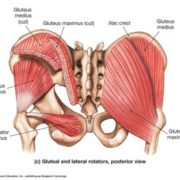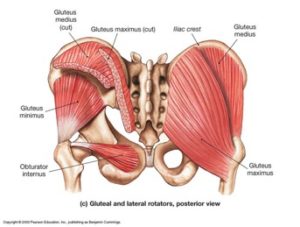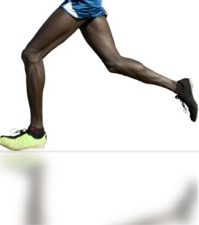Hip Extension for Efficient Running
(Unlocking the mystery which drives running)
By: John Fiore, PT
Runners of all abilities and ages strive to run efficiently and injury-free. While the importance of foot strike pattern and cadence will be addressed in future articles, this month’s article will focus on the role of hip extension to maximize running efficiency and reduce injury risk. Runners are often given general cues to improve running form which often result in further compensatory running patterns. “Running with an upright trunk” and “drive your hips and pelvis forward” cues in reality inhibit true hip extension by increasing lumbar spine compression through an anterior pelvic tilt. The first step to running efficiently is to understand what hip extension is.
Hip extension begins as the body passes behind the center of gravity of the body (pelvis, torso) during the running stride. Hip extension (coupled with knee and ankle extension) produces the power phase which drives running forward propulsion. A strong gluteus maximus is a must for hip extension in runners. The gluteus maximus is the primary hip extender while the hamstring assists. In the presence of an underactive or weak gluteus maximus, the hamstring assumes the role of hip extension which often leads to hamstring muscle overuse injuries.
It is difficult to evaluate true hip extension without a video running analysis with high- speed cameras to capture and objectively quantify hip joint extension angles. A real- time video running analysis will document hip extension while running. Think of a running stride as being comprised of two equal halves (hip flexion and hip extension). Similar to a pendulum, the hip excursion during hip extension (backward portion of the running stride) should approximate the hip excursion during hip flexion (forward portion of the running stride). Visualize your trunk and torso as the axis of a pendulum with hip extension equaling hip flexion.
Another function of hip extension is one of power transfer. Energy gained through gluteus maximus contraction and hip extension, is transferred into more efficient hip flexion during the forward swing phase of the running stride. A stretch reflex of the hip flexor muscle during hip extension results in a more efficient forward stride. Lifestyle consequences interfere with our natural, efficient running stride. Prolonged sitting increases the risk of hip flexor tightness (psoas, rectus femoris), an anterior tilt of the pelvis, and weak gluteal muscles (gluteus maximus, gluteus medius).
Restoring necessary hip extension while running is not achieved by running upright or driving the pelvis forward as many runners are instructed to do. Retraining the body to extend the hip while stabilizing the pelvis is possible only through core stabilization, functional (weight bearing) strengthening, and running video analysis. Without adequate pelvic stabilization, anterior tilting of the pelvis results in increased lumbar compression and increased hamstring muscle compensation.
The experts at Sapphire Physical Therapy can evaluate your running gait with our real-time 2D video running analysis. Based on the analysis data, an individualized functional strength, pelvis stabilization program will allow you to work towards pain-free running and detect underlying form or strength issues. Call Sapphire Physical Therapy or see learn more at www.sapphirept.com and let us help you successfully achieve your running goals.
John Fiore, PT
john@sapphirept.com







